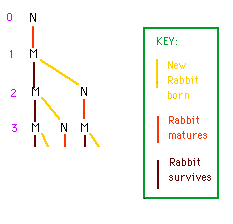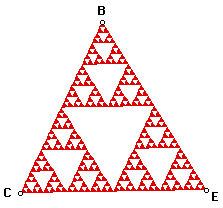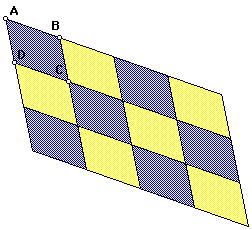

Mathematics is sometimes defined as the science of patterns. What do we mean by a "pattern"? A mathematical pattern involves regularity. This regularity may manifest itself in shape, direction, orientation, size, or number relationships, among other things. The key to being a pattern is that there is some regularity that can be repeated, extended, or built upon.
Recommended
Investigations
Consecutive Odds and
Evens
Choose four consecutive odd counting numbers.
Take the product of the middle two and subtract the product of the first and the
last. Try a few samples and formulate a rule. Explain why the rule works.
Extension: What if you used four consecutive even counting numbers in the above problem? Would your rule change? If so, what would the new rule be? Explain why this new rule works and why it is different from the original rule. If the rule does not change, would your explanation change?
Extension: What if you used four consecutive counting numbers? Would your rule change? If so, what would the new rule be? Explain why this new rule works and why it is different from the original rule(s). If the rule does not change, would your explanation change?
Related External Links:
Patterns in a
Table
This is part of a table of values of
3S2 + T2. Values of S are down the left-hand side and
values of T are along the top. Expand the table to larger values of S and T and
investigate any patterns you can find.
|
T | |||||||||||||||
| 1 | 2 | 3 | 4 | 5 | 6 | 7 | 8 | 9 | 10 | 11 | 12 | 13 | |||
|
| |||||||||||||||
| 1 |
|
4 | 7 | 12 | 19 | 28 | 39 | 52 | 67 | 84 | 103 | 124 | 147 | 172 | |
| 2 | 13 | 16 | 21 | 28 | 37 | 48 | 61 | 76 | 93 | 112 | 133 | 156 | 181 | ||
| S | 3 | 28 | 31 | 36 | 43 | 52 | 63 | 76 | 91 | 108 | 127 | 148 | 171 | 196 | |
| 4 | 49 | 52 | 57 | 64 | 73 | 84 | 97 | 112 | 129 | 148 | 169 | 192 | 217 | ||
| 5 | 76 | 79 | 84 | 91 | 100 | 111 | 124 | 139 | 156 | 175 | 196 | 219 | 244 | ||
| 6 | 109 | 112 | 117 | 124 | 133 | 144 | 157 | 172 | 189 | 208 | 229 | 252 | 277 | ||
| 7 | 148 | 151 | 156 | 163 | 172 | 183 | 196 | 211 | 228 | 247 | 268 | 291 | 316 | ||
Related External Links:
Fractions into Whole
Numbers
Find three whole numbers, a, b and c, which
will make this fraction a whole number:
bc + ac + ab
a + b
+ c
Can you find a method which will give many such solutions? Explain why this method works.
Related External Links
McNugget Numbers
McDonalds sells Chicken McNuggets in boxes of 6, 9, or 20. Obviously one
could purchase exactly 15 McNuggets by buying a box of 6 and a box of 9.
Could you purchase exactly 17 McNuggets?
How would you purchase exactly 53 McNuggets?
What is the largest number for which it is impossible to purchase exactly that number of McNuggets?
What if the McNuggets were available in boxes of 7, 11, and 17? What is the largest number for which it is impossible to purchase exactly that number of McNuggets?
Related External Links
Multiplying
Rabbits
A newly born rabbit is capable of
reproducing when it matures at one month old. Suppose the rabbit never dies and
continues reproducing every month. So, when the rabbit is born, it has one
member in its own family. After a month, it matures, and by the second month it
adds a new born member to its family. In the third month, the rabbit produces
another offspring, and its first child matures, and will be ready to have an
offspring in the next month.

The sequence named by
Fibonacci: 1,1,2,3,5,8,13,21,... can describe the number of family
members at each month. Explain how.
Extension: Compare the ratio of consecutive numbers in this sequence. For example 1/1, 1/2, 2/3, 3/5, 5/8, ....What do you notice after a while?
Related External Links:
Fibonacci Extended
Choose two numbers. Add them together and form a Fibonacci-like
sequence, starting with your first two numbers, and ending with a total of ten
numbers. Repeat the process with two different numbers.
What is the relationship between the seventh terms and sum of the terms of your sequence? What is the relationship between the seventh and tenth term of your sequence? Explain.
Extension: Would your result be different if you started with negative numbers or fractions?
Related External Links:
Going Fishing
A professional bass fisherman caught 385 bass during a 14-day
tournament. Each day, he caught three more fish than he did the day before. How
many fish did the fisherman catch on each day?
Extension: Generate a shortcut to check the total number of fish caught throughout the tournament by using only the first day's catch, last day's catch, and number of days in the tournament. Explain your reasoning.
Related External Links:
Infinite Series
Find the sums in each of the following series:
1/2 + 2/4 + 3/8 + 4/16 + 5/32 + . . .
1/2 + 3/4 + 5/8 + 7/16 + 9/32 + . . .
1/1 + 1/2 + 1/3 + 1/4 + 1/5 + ...
Explain how you found your answers.
Related External Links:
|
1 |
1 |
|||||||||||||||
|
1 |
2 |
1 |
||||||||||||||
|
1 |
3 |
3 |
1 |
|||||||||||||
|
1 |
4 |
6 |
4 |
1 |
||||||||||||
|
1 |
5 |
10 |
10 |
5 |
1 |
|||||||||||
|
1 |
6 |
15 |
20 |
15 |
6 |
1 |
||||||||||
|
1 |
7 |
21 |
35 |
35 |
21 |
7 |
1 |
|||||||||
|
1 |
8 |
28 |
56 |
70 |
56 |
28 |
8 |
1 |
Pascal's Patterns
What is the sum of each row? Find a way to describe the pattern of sums
when comparing it to the row number.
Extension: What other patterns do you notice in this triangle of numbers?
Related External Links:
Hot Air Balloons
A hot air balloon moves up 200 feet during its first minute of flight,
and then will continue to rise each minute thereafter for a distance of 80% of
its previous minute. If you ignore air pressure, will the balloon fly out into
space? Explain why or why not.
Related External Links:
Additional
Investigations
Generating and Generalizing
Sequences
Squares on a Checkerboard
How may squares, of any size, are on a 3 x 3 checkerboard? 4 x 4? 8 x 8?
n x n? Explain how you arrived at your answers.
Completing the Sequence
Find the next numbers in each of these sequences:
|
-4 |
-1 |
2 |
5 |
8 |
11 |
14 |
17 |
20 |
|
-1 |
0 |
3 |
8 |
15 |
24 |
35 |
48 |
63 |
|
-128 |
-54 |
-16 |
-2 |
0 |
2 |
16 |
54 |
128 |
Sum of Consecutive
Integers
How many integers from 10 to 40 can be
written as the sum of 2 consecutive integers?
How many integers from 10 to 40
can be written as the sum of 3 consecutive integers?
How many integers from
10 to 40 can be written as the sum of 4 consecutive integers?
Can you find a pattern? Explain.
Triangular Numbers
Consider the pattern formed by these dots.

The number used to describe each "triangle" is called a triangular number. Given a number, can you arrange that many dots into a triangle? If you can, you have identified a triangular number. The sequence of triangular numbers starts with 1, 3, 6, and so on.
Draw a picture of the next triangle in the sequence and state the next triangular number.
Without drawing any more triangles, determine the next five triangular numbers and explain how you found your results.
Extension: Investigate the pattern with square numbers.
Analyzing and Applying Sequences
|
1 |
1 |
|||||||||||||||
|
2 |
2 |
2 |
||||||||||||||
|
3 |
4 |
4 |
3 |
|||||||||||||
|
4 |
7 |
8 |
7 |
4 |
||||||||||||
|
5 |
11 |
15 |
15 |
11 |
5 |
|||||||||||
|
6 |
16 | 26 |
30 |
26 |
16 |
6 |
||||||||||
|
7 |
22 |
42 |
56 |
56 |
42 |
22 |
7 |
|||||||||
|
8 |
8 |
Triangles inside Triangles
This triangle starts with the outside diagonal rows 1, 2, 3, 4, 5, 6, 7,
8, . . .
The inside numbers are each the sum of the two numbers in the previous row, above right, and above left. For example, 42 = 16 + 26.
Extend the table and determine a relationship between the
numbers in the triangle which are exactly divisible by one specific prime
greater than 5 . How do the results change if you try another prime greater than
5?
Infinite Series and Partial Sums
Sum of Natural Numbers
Given that 1 = 1, 1 + 2 = 3, 1 + 2 + 3 = 6, and 1 + 2 + 3 + 4 = 10, what
is the sum of the numbers from 1 to 100? Explain how you found your
answer.
Extension: What does 1 + 2 + 3 + 4
+ 5 + 6 + . . . + n equal? Give your answer in terms of n. Explain your
solution.
Repeating Patterns
In the following decimal, how many 2's are there in all before the
hundredth 3?
0.23223222322223. . .
Geometric
Fractal Iterations
The diagrams below represent the stages involved in constructing a
fractal, an infinite pattern where the initial stage is visible in
smaller pieces of the image. Each step in the process is called an
iteration.
|
|
|
| |
|
|
Draw the 3rd iteration and describe how you made it.
Extension:
Describe how you would generate Sierpinski's triangle shown below.

Tessellating a Plane
The blue parallelogram ABCD shown below has been tessellated so that it
tiles a surface without any gaps or overlaps. Name as many other quadrilaterals
that can also tessellate a flat surface. Explain your solution.

View a Geometer's SketchPad template or a java applet of this construction to convince yourself.
Extension:
Name as many other individual polygons that can tessellate a flat surface. Justify your answer(s).
Extension:
What combination(s) of polygons can tessellate a flat surface? Explain why those combination(s) work while others do not.
Puzzles
The Next Row
Complete the ???? row in this problem. Explain how you found the
solution.
1
11
21
1211
111221
312211
13112221
1113213211
??????????????
What Time is It?
Determine the next value in the sequence: 900, 945, 1030, 1115, 1200,
???
Explain your reasoning.
The 26th Degree
What is (x-a)(x-b)(x-c)...(x-y)(x-z)? Explain how you found the
answer.
Horizontal
Inquisition
Draw the next figure in the
sequence

Explain how you determined the
result.
Playing for Sticks
I lay out twenty sticks on the table and we play a "pick up the sticks
game." You can pick 1, 2, 3, or 4 sticks during your turn, and the loser is the
person who is left with the last stick laying on the table. If I let you pick up
sticks first, how can you devise a strategy to win every time?
Extension: Suppose you can choose the number of sticks at the start of the game. If your opponent goes first, then how many sticks do you want at the start if you want to win every time?
Extension: How would the strategy change if you could pick only 1,2, or 3 sticks during your turn?
interMath Patterns Lesson Resources
Choose one of the categories below or scroll down to view resources related to number patters
Applications
and Connections
Lessons,
Activities, and Units
Literature
Problem
Solving
Puzzles
Book titles related to Fibonacci numbers
Chaitin, Gregory J. 1988. Randomness in arithmetic. Scientific American (July):80-85.
Gardner, Martin. 1989. Pascal's triangle. In Mathematical Carnival. Washington, D.C.: Mathematical Association of America.
Garland , T. H. Fibonacci Fun: Fascinating Activities with Intriguing Numbers. Dale Seymour Publications, 1990.
Johnson, A. Now & Then: Fiber Meets Fibonacci. Mathematics Teaching in the Middle School. Reston, Va: NCTM, Jan 1999 Vol 4, No. 4.
Lawler, Robert. Sacred Geometry: Philosophy and Practice. London: Thames & Hudson, 1982.
Little, C. Teacher to Teacher: Geometry Projects Linking Mathematics, Literacy, Art, and Technology. Mathematics Teaching in the Middle School. Reston, Va: NCTM, Feb 1999 Vol 4, No. 5.
NCTM. "Tri-Square" Numbers. Mathematics Teaching in the Middle School. Reston, Va: NCTM, Apr-May 1995, pp. 408-9
NCTM. Exploring Patterns in Nonroutine Problems. Mathematics Teaching in the Middle School. Reston, Va: NCTM, 1999 Vol 4, No. 5. Feb 1997, pp. 26269
Pattern-Based Math and Science Curriculum
Pickover, Clifford A. 1990. On the aesthetics of Sierpinski gaskets formed from large Pascal's triangles. Leonardo 23(No. 4):411-417.
Runion, Garth. The Golden Section. Palo Alto, Calif.: Dale Seymour Publications, 1990.
Schroeder, Manfred. 1991. Fractals, Chaos, Power Laws: Minutes from an Infinite Paradise. New York: W.H. Freeman.
Sved, Marta. 1988. Divisibility - with visibility. Mathematical Intelligence
10(No. 2):56-64.
| Problem Solving | |
|
Fibonacci's Sequence Other Sequences Geometric Patterns |
Series and Partial
Sums The name game The complex apartment complex I know a secret Valentine treats Pancake man Run sums Pascal's Triangle Mrs Pascalini's garden Antonio's pizza palace How many Shamrocks do you see? |
| Puzzles | |
| It's
a secret Nim skulls Tower of Hanoi The Moscow Puzzles - A Pattern The little math puzzle contest Fibonacci Puzzles |
Revised September 27, 1999
interMath Patterns History Resources
Choose one of the categories below or scroll down to view historical resources related to patterns
Historical
References
Literature
Mathematicians
Historical
References
Codebreaking and Secret Weapons
in World War II
Tower of
Hanoi problem
Development of mathematics
in ancient China
Fractal
History
Tessellations
and mathematics: A logical connection
Totally Tessellated:
History
Boyer, Carl B. 1968. A History of Mathematics. New York: Wiley.
Hofstadter, D. R. Godel, Escher, Bach : An Eternal Golden Braid. Basic Books: 1999.
Johnson, Art. Classic Math: Historical Topics for the Mathematics Classroom.
Palo Alto, Calif.: Dale Seymour
Publications, 1992.
National Council of Teachers of Mathematics (NCTM). Historical Topics for the
Mathematics Classroom. Reston, Va.:
NCTM, 1969, 1989.
Zaslavsky, C. Africa counts: number and pattern in African culture. Prindle, Weber & Schmidt, Boston, 1973.
Mathematicians
Fibonacci
Gauss
Pascal
click
this image to go to opening page